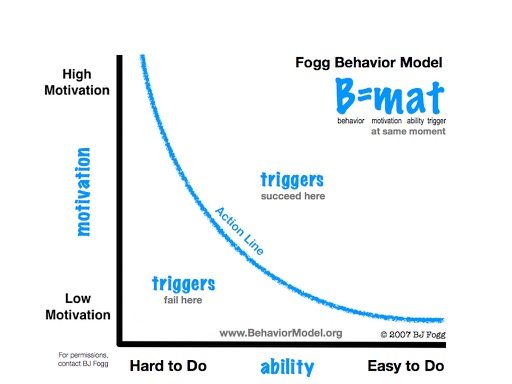- author:: BJ Fogg

- This model isn't based on experimental evidence, but is rather a bunch of formalized common-sense assumptions. Use it as a set of rules of thumb that are generally good to follow and don't pretend like it's all the psych you need to make a good product and you'll be fine.
- Not much scientific evidence behind this model specifically, but seems like it’s essentially a formalization of Friction and Fuel/3Bs, positive pressures/negative pressures, etc. with some common sense assumptions built in. they’re all saying more or less the same thing- cost/benefit!
- Using it well- don’t assume this is all that you need to know about behavioral science to make a good product. This is essentially formalized common-sense.
- Ability
- "Make it simple, remove steps. This is what UX designers do best."
- Does the user have the necessary skills, energy, time, or other resources to do some behavior? Has the user built up the necessary amount of Self-efficacySelf-efficacy
Self-efficacy is the belief that you are capable of doing some action, otherwise phrased in here as The user believes that they are capable of performing actions within the app and The user believes that their actions in the app lead to goal achievement.
Self-efficacy is associated with (Bandura, 1998):
setting higher standards in relation to goals
greater effort, persistence, and concentration
adopting a flexible approach to overcoming problems
treating errors as learning experienc...?
- Motivation:
- This is the part where UX designers tend to struggle.
- Self-efficacy is one way to boost motivation
- Ability
- Implications of the model
- If motivation is higher than ability when the user is prompted, they will do the behavior.
- I’d rephrase this as if motivation is higher than ability when the user is prompted, they are more likely to do the behavior than if not.
- diminishing marginal returns:
- If ability is already high, then making things a little easier will not make as much difference in the frequency of the behavior as increasing motivation
- if motivation is already high, making it a little more motivating will not make as much difference as increasing ability and making it easier.
- Motivation goes up and down in waves, as he refers to in motivation wavesmotivation waves
https://www.youtube.com/watch?v=fqUSjHjIEFg&feature=emb_logo
and motivation is harder to increase than ability.- This means:
- We should make things as low friction as possible in order to make our prompts more successful.
- If a user is experiencing high motivation, prompting them to do something easy is a waste.
- try to do motivation checkmotivation check
definition: A motivation check is a moment where you give a user a choice where what they choose reflects their current level of motivation.
According to BJ Fogg, we have motivation waves. Tie that in with the Fogg Behavior Model and you find that when people have high motivation, you should ask them to do something big and impactful, because if people are motivated to do more than the task that we ask them to do, it would be a waste for us not to prompt them to do so. On the flip side...s in order to give people the right activities at the right moment.
- This means:
- If motivation is higher than ability when the user is prompted, they will do the behavior.
Behavioral product strategist and gamification designer. This is my public hypertext notebook, sharing my thinking in motion at various stages of development.
Home
Fogg Behavior Model
© Rob Haisfield